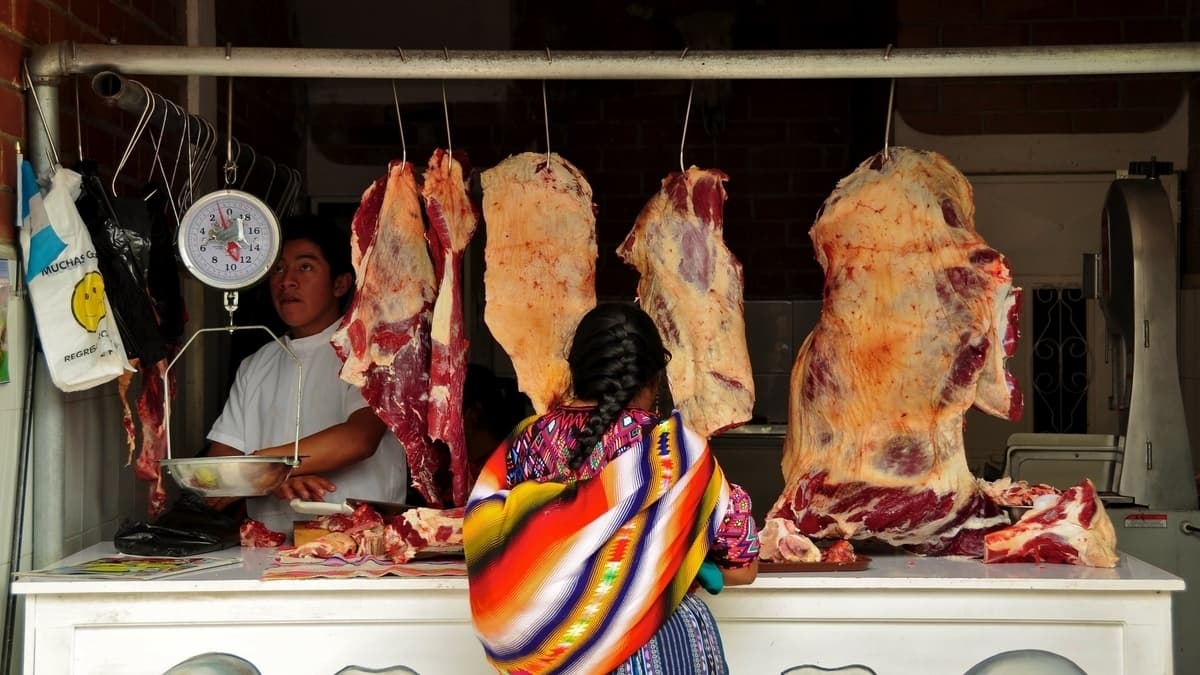A Gringo’s Guide To Meat Cuts in Guatemala
6 min readAn expat's guide to meat cuts in Guatemala to help you at the market or in the steakhouse (also applicable to other countries in Central America).
The post A Gringo’s Guide to Meat Cuts in Guatemala appeared first on Central America.

Are you a meat lover in the Land of Eternal Spring? If so, here’s an expat gringo’s guide to meat cuts in Guatemala to help you at the market or in the steakhouse.
A friend once said that if North Americans had to buy meat the way they sell it in the Mercado Municipal in Antigua, Guatemala, the number of vegetarians would triple overnight. At almost all the market butcher stalls, whole sides of beef and pork hang from hooks, without refrigeration, beset by flies. Chickens (dead ones) sit on counters splayed wide open to reveal the eggs forming inside them.
I’ve often wondered why they display the hens this way. Are the half-formed eggs a delicacy to some? Or is it a way of assuring a wary buyer they are not purchasing a rooster?
In the rear of the butcher section, there are vendors selling only the offcuts. Hearts, stomachs, kidneys, livers, and intestines. And also the primary ingredient of the classic Guatemalan dish revolcado: pig’s heads and pig or cow spleens.
Should you wish to buy, say, a cut of beef, you’d be wise to first become familiar with the various cuts of meat on offer. Due to a lack of ovens in many homes, most cuts on offer are almost paper thin. This enables easy cooking on the small charcoal grills common to Guatemalan households.
Outside of the high-end restaurants and steakhouses like Hector’s Bistro or Ni-Fu Ni-Fa, you won’t find meat cuts familiar to North Americans or Europeans. Here in Central America, they piece the animals out in a different way.
What Meats Are Called What?
The Spanish word “carne” refers to meat in general. Carne and beef are used interchangeably in Central America. Carne de res is the proper term for beef, though, so if you’re unsure about what specific animal is in your sandwich or stew, just ask if it’s res or not. The term for pork is cerdo (carne de cerdo), and pollo is chicken. Sometimes gallina (hen) also refers to chicken, although this term is less common nowadays.
Embutidos refers to a wide range of sausages. These include everything from herbaceous longanizas, mild-spiced chorizos, and the bland, pink small hot dogs known as salchichas. Ternera in Central America refers specifically to veal, as opposed to its definition in Spain as any type of beef. And talking of beef, bife is an Argentinean term for beef you see almost only in steakhouses or high-end restaurants. In most restaurants, they grill meat over an open flame parrilla (grill), which gives its name to a mixed-grill plate called a parrillada.
Seasonings, Condiments, and Specialities
Chimichurri is a popular condiment, originally from Argentina but used all over Latin America. It comprises minced parsley and garlic steeped in olive oil and you spoon it on top of the steak.
Even in fine-dining restaurants, the lack of seasoning on meat is often surprising. Adobado is a marinade often associated with pork but also used with beef or chicken. A complex mix of spices and achiote, it has a tangy flavor and a distinctive orange appearance. Chirmol is another topping. It resembles a tomato salsa but has no hot pepper element. It is a thin liquid made from pureed tomatoes, onion, and fresh herbs such as cilantro or mint.
Hilachas is a beef dish made with a skirt steak that has been slow-cooked or stewed to make it more tender. Revolcado – mentioned above – is a dish for those with a deep appreciation for offal cuts. Spleens and intestines stewed together, create an experience for those with a deep masochistic streak.
Meat Cuts in Guatemala Guide (Also Applies to the Rest of Central America)
With all that said, let’s get down to business to avoid any confusion while dining or shopping for your favorite cuts of meat in this part of the world:
Cuts Of Beef
“What say you to a piece of beef and mustard?” – William Shakespeare
- Lomito: One of most expensive cuts available, almost like a beef tenderloin. It comes cut into medallions and seared, or grilled whole and sliced afterward. Coming from near the spine of the animal, they remove the fibrous membranes before cooking.
- Lomo: Less expensive than lomito, it’s not as tender. Think of the difference between strip loin and tenderloin.
- Viuda: Most like sirloin, the viuda cut, (viuda being Spanish for “widow”), comes con/sin hueso (with/without the bone). It is one of the thicker cuts available.
- Puyaso: A rump steak, specifically from a steer, not a cow. It comes in two varieties, estandard and especial. The standard puyaso cut lacks an edge of fat present on the more costly special cut. Butchers sell puyaso cut very thin, so a buyer desiring a thicker cut should ask for a “corte grueso”.
- Bolovique: A less common style that refers not to a cut, but rather a source: steers that have just reached maturity. More often seen in restaurants than butcher shops.
- Bistec de Ternera: Steaks from calves of around six months old that are still unweaned.
- Arrachera: A popular cut, they call this a hangar steak in North America, due to its location below the diaphragm.
- Churrasco/Churrasquito: A common menu item. a catch-all term for many thin grilled beef steaks.
Cuts of Pork
“Any part of the piggy
is quite all right with me.
Ham from Westphalia, ham from Parma,
Ham as lean as the Dalai Lama,
Ham from Virginia, ham from York,
Trotters sausages, hot roast pork.
Crackling crisp for my teeth to grind on,
Bacon with or without the rind on.
Though humanitarian I’m not a vegetarian.
I’m neither crank nor prude nor prig.
And though it may sound infra dig,
Any part of the darling pig
is perfectly fine with me.”
– Noel Coward
- Chuleta: A thin-cut chop. It is usually served bone-in, but sometimes available deshuesado or deboned. Common preparations are adobado or ahumado (smoked).
- Pata de Cerdo: A sliced pig foot. Cut very thin and cooked in a sauté pan or skillet.
- Lomo de Cerdo: Roughly corresponds to the loin or tenderloin. Again, thin cut and grilled.
- Pierna: Means “leg” in Spanish. It refers to either an uncured ham or what we call stew meat in North America.
- Carnitas: Meat that has been slow-cooked, pulled apart and re-fried in oil or lard to give it a crispy texture and rich fattiness.
- Chicharrones: Small chunks of fat, skin and the belly of a pig deep-fried to a crispy, puffy texture. Best purchased as fresh as possible. Most aficionados have a specific market stall or chicharronería (a restaurant specializing in chicharrones) they swear by. A common snack best paired with a cold beer, you know you have authentic chicharrones when you need to pick off the small hairs that remain before eating.
Chicken
We should close with chicken, I guess, although I’m not too sure if it counts as “meat” to a red-blooded carnivore. You know what I mean – I’m being flippant here. Chicken is a major staple in Guatemala. Like all good Central Americans, Guatemalans love their fried chicken (pollo frito). I mean the name of the national beer is Gallo (rooster), for gawd’s sake.
There are not too many “cuts” of chicken – you can either buy the whole thing splayed out in the market, embryos and all, or you can buy them by the breast, wing, or thigh.
Chicken breast is pechuga and comes with or without skin (con/sin piel). If it’s a nice piece of thigh you seek, ask for muslo. And for wing-lovers, you’ll want alas or alitas. Like anywhere else, alitas de pollo go down so well with a cold Gallo in front of the game. Actually, all meat goes down well with any cold beer in front of any game, come to think of it.



